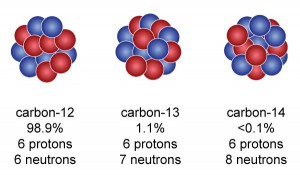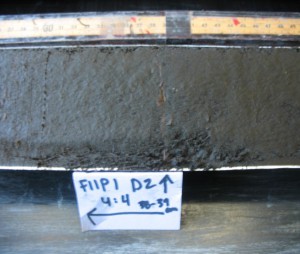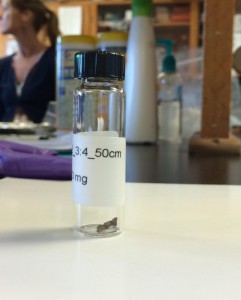C14 Dating Techniques
What is 14C?
Carbon is one of the elements which all living things are composed of. The most common form of carbon is carbon-12 which has 6 protons and 6 neutrons. 99 percent of all the carbon in the world is carbon-12 but some carbon atoms (isotopes) have additional 1 or 2 neutrons. These isotopes are called carbon-13 and carbon-14 respectively.
Where does 14C come from?

Carbon-14, the isotope with 8 neutrons, is created in the atmosphere. Cosmic rays enter the atmosphere from space and create energetic neutrons. When one of these energetic neutrons collides with a nitrogen atom (7 protons and 7 neutrons), it forces out one of the protons, creating a Carbon-14 atom (6 protons and 8 neutrons).
Defining the age of a rock or cave painting from Learn Chemistry
How does 14C tell us the age of organic materials?

14C acts much like regular carbon-12 so it is taken up by plants through photosynthesis, and by animals when they eat plants.
Though 14C is present in all living things, it is a rare, unstable isotope which means that over time it decays. Every 5730 years, half of the 14C atoms within a sample decay. To determine the age of a sample we compare the ratio of Through comparing the amount of 14C atoms remaining in the sample and the amount of 14C in an atmospheric standard, we can discover how many years old the sample is.
How do we use 14C dating?
Carbon-14 (14C) dating is used to determine the age of organic material which we discover in our cores, such as leaves, roots, or bone which are found within the sediment core.
Explanation of results

After being pulled from sediment cores and prepared in the lab samples are sent to the National Ocean Sciences Accelerator Mass Spectrometry Facility (NOSAMS) to be analyzed (more on that process here http://www.pbs.org/wgbh/nova/tech/radiocarbon-dating.html). NOSAMS returns results in a spreadsheet which shows the age of the sample and the amount of error. These results are then calibrated and used to model the age of the sediment based upon depth. (example excel file saved in CRLers folder)
Dry, clean organic material in a vial ready to be sent to NOSAMS for analysis
Sources:
What is Carbon Dating?
from NOSAMS
How Carbon-14 Dating Works
from how stuff works
Radiocarbon Dating
from NOVA, WGBH
Carbon Dating
from Hyperphysics
